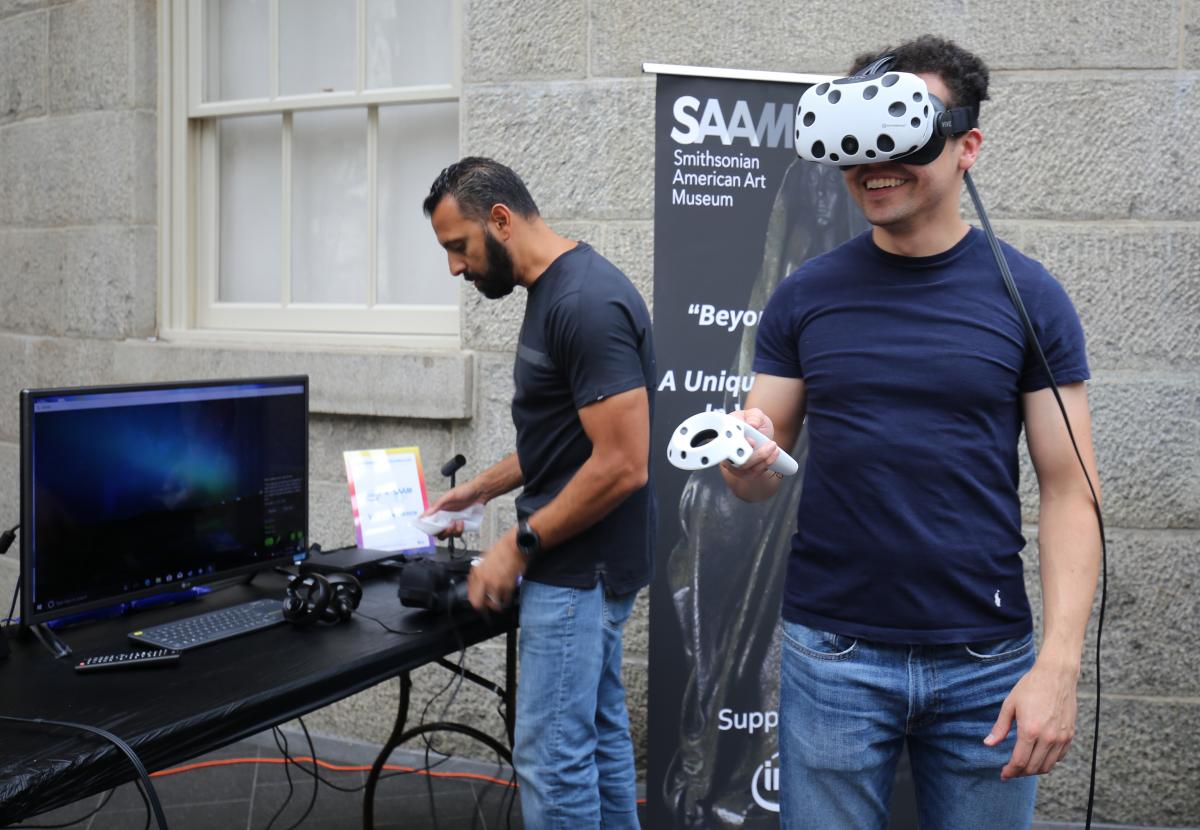Beyond the Walls is a virtual reality experiment from SAAM and Intel, building on our use of VR to expand exhibitions such as WONDER and No Spectators: The Art of Burning Man. In Beyond the Walls, visitors are transported into SAAM’s historic building—then to relevant sites outside the museum—for an immersive experience with selected artworks. Our summer intern and renaissance man, Noah Kim, helped us test Beyond the Walls, and he describes his work below:
During my internship with the Smithsonian American Art Museum’s External Affairs and Digital Strategies department, I have been super lucky to use the VIVE Pro for a variety of virtual reality experiences. Though it was my first time using a VR headset, it was user-friendly enough for me to become acquainted with it right away. The headset feels comfortable to wear, and the visuals are shockingly convincing.
Right away, being immersed in virtual reality made me smile with surprise. I’ve grown up with all kinds of cool, new technology, but virtual reality was always “that thing we’ll have in the future.” Next thing I know, I’m in the office setting up the headset, and then the next minute I’m at SAAM and the Renwick Gallery, all without leaving the actual room.
I especially enjoyed the ability to “jump into” certain artworks in the museum, like Frederic Edwin Church’s Aurora Borealis. Teleporting (entering different rooms or environments via a handheld device) from a hallway to the starry, glowing skies above a tundra is as magical as it sounds. I could almost feel the chill emanating from the icy rocks surrounding me. Jumping from there to Washington, DC’s Rock Creek Cemetery to see the foreboding Adams Memorial by Augustus Saint-Gaudens in its natural setting, I was met by the ambiance of bugs and wind associated with being outdoors in a park.
This method of contextualization is where virtual reality truly shines. In a museum, you typically have art accompanied by captions and wall text. But many artworks weren’t necessarily made to be housed in a museum, so the museum has some burden to convey the context without encroaching on the territory of other artworks it shares space with.
That’s not a problem anymore, now that we can jump into the private worlds of the artworks themselves. People go to museums to be brought to different places, guided by exhibitions. Now, I can walk right into different worlds, as though they were part of the exhibition! Even worlds that no longer exist, or never existed! I can get as close to the artworks as possible without fear of setting off alarms or damaging anything. It is also nice and quiet, or at least as quiet as the room that you’re in.
Also interesting was the artist commentary found in the room that featured Alex Prager’s 2013 video, Face in the Crowd. First, I teleported into the room. Then, with a touch of a button, a figure of Prager appeared before me, telling me all about her video. Receiving these behind-the-scenes comments from Prager herself certainly made it all the more engaging. I see huge potential in this for digital art installations in particular because the nature of virtual reality allows for infinite construction—no more worries about setting up giant screens to cover three whole walls in a confined space.
All in all, working with VR was a blast. I look forward to more immersive experiences that let you teleport to works of art from all over the world.
Related Content:
- If you have a VR headset, you can explore No Spectators: The Art of Burning Man on Sansar.
- Mobile users can download WONDER 360, a VR app representing the Renwick Gallery's immersive and awe-inspiring installations from 2015-16.






















